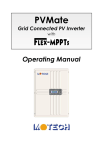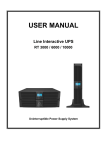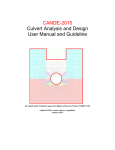Download User`s Manual
Transcript
Owner’s Manual PVMate Grid Connected Solar Inverter PVMate 6500U / 7500U © 2011 MOTECH All rights reserved V1.1 Importance Safety Instructions SAVE THESE INSTRUCTIONS– This manual contains important instructions for Models PVMate 7500U, PVMate 6500U that shall be followed during installation and maintenance of the PV inverter. Safety Precautions/Safety Notes Only trained qualified electrical personnel are to perform the electrical installation, wiring, opening and repair of the PVMate inverters. Even when no external voltage is present, the PVMate inverters can still contain high voltages and the risk of electrical shock. WARNING! THESE SERVICING INSTRUCTIONS ARE FOR USE BY QUALIFIED PERSONNEL ONLY. TO REDUCE THE RISK OF ELECTRIC SHOCK, DO NOT PERFORM ANY SERVICING OTHER THAN THAT SPECIFIED IN THE OPERATING INSTRUCTIONS UNLESS YOU ARE QUALIFIED TO DO SO. AVERTISSEMENT! CES INSTRUCTIONSS’ADRESSENT À UN PERSONNEL QUALIFIÉUNIQUEMENT. POUR RÉDUIRE LE RISQUE DE CHOCÉLECTRIQUE, N’EFFECTUER AUCUN AUTREDÉPANNAGE QUE CELUI INDIQUÉ DANS LA NOTICED’EXPLOITATION À MOINS QUE VOUS NOUSSOYEZ QUALIFIÉ POUR LE FAIRE. The temperature of the heat sinks outside of the device can reach over 70°C (158°F) in normal operation (Ambient temperature rating: 50°C / 122°F). There is the risk of burn injury when these parts are touched. The following general safety precautions must be observed during all phases of operation, service, installation and repair of this device. Failure to comply with these precautions or with specific warnings elsewhere in this manual violates safety standards of design, manufacture, and intended use of the device. The manufacturer assumes no liability for the customer’s failure to comply with these requirements. Safety Symbols To reduce the risk of injury and to ensure the continued safe operation of this product, the following safety instructions and warnings are marked in this manual. Warning, risk of electric shock Presents safety information to prevent injury or death to users and/or installers. Earth ground symbol ! Caution (refer to accompanying documents) Presents information to prevent damage to this product. General Safety Precautions Personnel must remove all conductive jewelry or personal equipment prior to installation or service of the device, parts, connectors, and/or wiring. Trained qualified personnel are required to mount, reconfigure or repair this device. Licensed electricians are required to install permanently wired equipment. Stand on an insulated surface when working on the operating device (i.e., ensure that there is no grounding). Instructions in this manual must be precisely followed and all information on cautions or warnings must be adhered to. Use proper lifting techniques whenever handling enclosure, equipment or parts. The PVMate inverter must be provided with an equipment-grounding conductor connected according to local codes and regulations. The PVMate inverter must be provided with a DC grounding connection according to NEC and Local Electrical codes. The grounded conductor must be ungrounded and energized when ground fault is indicated. The AC Neutral connection is only for voltage sensing and shall be neither used to carry currents nor bonded to ground inside the inverter. The list does not contain all measures pertinent to the safe operation of the device. If special problems arise which are not described in sufficient detail for the purposes of the buyer, contact your specialized dealer or technician. Safe Installation and Operation Installation of the device must be in accordance with the safety regulations (e.g., UL1741) and all other relevant national or local regulations. Correct grounding and short circuit protection must be provided to ensure operational safety. Read all instructions and cautionary remarks in the manual before installation. Switch off the circuit breakers before installation and wirings. Avoid standing in water when working on the inverter. PV arrays will be energized when exposed to light. Cover the arrays with opaque (dark) material during installation and wiring. Check both of the AC and DC connections with a digital volt meter prior to any installation or removal procedures. Attach the outer cover correctly before switching on the circuit breakers. Install the inverter out of direct sunlight. When no external voltage is present; the PVMate inverter can still contain high voltages and the risk of electrical shock. Allow at least 5 minutes for the inverter to discharge completely after disconnecting the AC and DC sources from the inverter. External heat sinks can reach high enough temperatures in normal operation to cause skin burn injury when these parts are touched. Pay attention to high temperature components. To prevent the risk of fire hazard, do not cover or obstruct the heat sink. Allow changes in your electrical system to be carried out only by qualified electricians. Repair and Maintenance The PVMate inverter contains no user serviceable parts, except for the fan, the PV string fuses, GFDI fuse and the clock battery. Only MOTECH-trained staff is authorized to carry out internal repair and maintenance of the unit. Please return the device for repair and maintenance for faults caused by parts other than the fan and the fuses described above. For maintenance and replacement of the fuses, please refer to the section 5.4. WARNING! Not to make alterations or use tampering assembly in the inverter without manufacturer’s authorization unless specified elsewhere in this Manual. They may result in injury, electric shock, or fire and void the warranty. Wiring the inverter Input/Output Terminals: Use 90°C (194°F), #10 AWG to #6 AWG copper wire for DC wiring and #8 AWG to #6 AWG copper wire for AC wiring connections. The maximum size of wire terminals in wiring box accept is #6 AWG. Use only solid or stranded wire but not fine-stranded wire. Reconfirm that all connections have been performed properly and all screws are properly tightened. WARNING! All electrical installation and the wiring methods shall be done in accordance with the local and National Electrical codes ANSI/NFPA 70 and should follow the important safety instructions in this manual. WARNING! Make sure that you use suitable connecting cables for both the AC and DC wiring. The cable must be adequately dimensioned and suitably inert to temperature fluctuation, UV radiation and other possible hazards. Connection of the AC cable WARNING! Reconfirm that the circuit breaker to the main utility is switched OFF before connecting the power cable from the breaker to the AC connector. Connection of the DC cable CAUTION! ! Identify the different polarity of DC voltage on each PV string and connect respectively to the input terminals marked “UNGROUNDED CONDUCTOR” and “GROUNDED CONDUCTOR”. Make sure the DC voltage that PV arrays generate is equal or less than 600 VDC in any case. WARNING! Route the DC connection cables to the PVMate inverters away from any possible hazards that could damage the cables. WARNING! Hazardous voltage is still present on the device after disconnection of all PV DC inputs. Allow 5 minutes for the inverter to discharge the energy completely. WARNING! PV arrays will be energized when exposed to light. Cover the arrays with opaque (dark) materials during installation and wiring. Contents 1. INTRODUCTION .............................................................................. 1 1.1 GENERAL................................................................................................1 1.2 SPECIFICATIONS .......................................................................................3 1.3 ACCESSORIES ..........................................................................................6 2. INSTALLATION ................................................................................. 7 2.1 PLACEMENT ............................................................................................7 2.2 MOUNTING ............................................................................................9 2.3 WIRING THE INVERTER ............................................................................15 2.3.1 Connection of the AC cable ...............................................................21 2.3.1.1 Connection for AC 208 / 240V Utility (Default) .................................24 2.3.1.2 Connection for AC 277V Utility ..........................................................26 2.3.2 Connection of the DC cable ...............................................................29 2.3.2.1 Connection of the DC wires for Negative Ground Arrays ..................32 2.3.2.2 Connection of the DC wires for Positive Ground Arrays ....................34 2.3.2.3 Connection of the DC wires for Negative Ground Arrays without Internal DC Fuses...............................................................................37 2.3.2.4 Connection of the DC wires for Positive Ground Arrays without Internal DC Fuses...............................................................................40 2.3.3 Connection of the Communication cable ..........................................43 2.4 Wiring inverter in parallel .................................................................48 3. OPERATION .................................................................................. 49 3.1 OVERVIEW............................................................................................49 3.2 OPERATION FEATURE ..............................................................................51 3.3 LED INDICATION ....................................................................................52 3.4 LCD DISPLAY ........................................................................................54 3.5 COMMUNICATION ................................................................................. 71 3.6 EXPLANATIONS OF ERROR MESSAGES........................................................ 71 4. WARRANTY INFORMATION .......................................................... 75 5. TECHNICAL DOCUMENTATION ...................................................... 79 5.1 OUTLINE DRAWING ................................................................................79 5.2 EFFICIENCY ...........................................................................................80 5.3 DE-RATING OPERATION ...........................................................................83 5.4 MAINTENANCE ......................................................................................87 5.4.1 Exchange of the GFDI Fuse ................................................................87 5.4.2 Exchange of the PV String Fuses .......................................................89 5.4.3 Factory Service ..................................................................................90 5.4.3.1 Remove the Inverter ..........................................................................91 5.4.3.2 Re-install the Inverter ........................................................................97 5.4.4 Replace the clock battery ............................................................... 104 5.4.5 Set the clock ................................................................................... 105 List of Figures Fig1.1.1 System Overview ...............................................................................2 Fig 2.1.1 Clearances required for PVMate inverter installation .....................8 Fig 2.2.1 Removal of the bracket from the inverter ........................................10 Fig 2.2.2 Inverter mounting bracket............................................................... 11 Fig 2.2.3 Fasten the mounting bracket ...........................................................12 Fig 2.2.4 Hook the Inverter on the mounting bracket and then fasten the screw ..............................................................................................15 Fig 2.3.1 Turn the DC/AC disconnect switch OFF ........................................16 Fig 2.3.2 Loosen the screws ...........................................................................16 Fig 2.3.3 Remove the cover of the wiring box ................................................17 Fig 2.3.4 Removal of the covers for the cable through holes .........................17 Fig 2.3.5 Wiring box front view ......................................................................18 Fig 2.3.6 Utility configuration jumpers ..........................................................20 Fig 2.3.7 Utility configurations ......................................................................21 Fig 2.3.1.1 AC Terminal Block for AC cable connections with 208/240V .........25 Fig 2.3.1.2 AC Terminal Block for AC cable connections with 277V ................27 Fig 2.3.2.1 PV- terminal connection .................................................................30 Fig 2.3.2.1.1 DC terminal blocks for DC cable connection in Negative Ground ...........................................................................................33 Fig 2.3.2.2.1 DC terminal blocks for DC cable connection in Positive Ground ...........................................................................................35 Fig 2.3.2.3.1 DC terminal blocks for DC cable connection in Negative Ground array without internal DC Fuses ......................................38 Fig 2.3.2.4.1 DC terminal blocks for DC cable connection in Positive Ground array without internal DC Fuses ......................................41 Fig 2.3.3.1 Positions of the communication ports and termination switch .......44 Fig 2.3.3.2 Pins and Signals .............................................................................45 Fig 2.3.3.3 RS-232 connection ..........................................................................46 Fig 2.3.3.4 RS-485 connection ..........................................................................46 Fig 2.3.3.5 DIP Switch for RS485 Communication Address .............................47 Fig 2.3.3.6 Two(2) ways to connect the communication cables ........................47 Fig 2.4.1 Parallel configuration of inverter ...................................................48 Fig 3.3.1 Front panel of the PVMate inverter ................................................52 Fig 3.4.1 PVMate inverter LCD display lay-out ............................................70 Fig 5.1.1 Outline Drawing of PVMate 6500U/7500U ...................................79 Fig 5.1.2 CEC Efficiency of the PVMate 6500U = 96.0% (277V) .................80 Fig 5.1.3 CEC Efficiency of the PVMate 6500U = 96.0% (240V) .................80 Fig 5.1.4 CEC Efficiency of the PVMate 6500U = 95.5% (208V) .................81 Fig 5.1.5 CEC Efficiency of the PVMate 7500U = 96.0% (277V) .................81 Fig 5.1.6 CEC Efficiency of the PVMate 7500U = 96.0% (240V) .................82 Fig 5.1.7 CEC Efficiency of the PVMate 7500U = 95.5% (208V) .................82 Fig 5.3.1 Temperature derating curve of the PVMate 6500U(208V) .............84 Fig 5.3.2 Temperature derating curve of the PVMate 6500U(240V) .............85 Fig 5.3.3 Temperature derating curve of the PVMate 6500U(277V) .............85 Fig 5.3.4 Temperature derating curve of the PVMate 7500U(208V) .............86 Fig 5.3.5 Temperature derating curve of the PVMate 7500U(240V) .............86 Fig 5.3.6 Temperature derating curve of the PVMate 7500U(277V) .............87 Fig 5.4.1.1 Replacement of the GFDI fuse ........................................................88 Fig 5.4.2.1 Replacement of the PV string fuses .................................................89 Fig 5.4.3.1.1 Remove the cover of the Inverter ....................................................92 Fig 5.4.3.1.2 Remove the DC and AC wires .........................................................93 Fig 5.4.3.1.3 Remove the nuts bonding between the inverter and wiring box ......93 Fig 5.4.3.1.4 Remove the screws bonding at the sides of the inverter ..................94 Fig 5.4.3.1.5 Un-hang the inverter carefully ........................................................94 Fig 5.4.3.1.6 Locate the cover plate in place and fasten the screws ....................96 Fig 5.4.3.2.1 Re-install the cover plate and fix it at the back of the wiring box ...99 Fig 5.4.3.2.2 Hang the inverter onto the mounting bracket carefully ..................99 Fig 5.4.3.2.3 Fasten the screws bonding at the sides of the inverter .................100 Fig 5.4.3.2.4 Fasten the nuts bonding between the inverter and the wiring box for its construction and grounding ...............................................100 Fig 5.4.3.2.5 Connect the AC and DC wirings to their correct terminals individually ..................................................................................101 Fig 5.4.3.2.6 Put back the cover of the wiring box ............................................101 Fig 5.4.3.2.7 Fasten the screws of cover of the wiring box then ........................102 Fig 5.4.4.1 Replace the clock battery ..............................................................104 1. Introduction 1.1 General The Motech Industries PVMate product family is a series of grid-connected photovoltaic inverters which are designed to convert DC power generated by photovoltaic arrays to AC power that is delivered to the home loads and then fed into the utility grid with any excess power. The PVMate 6500U and PVMate 7500U are the members of the family for the North American market. The overview of the grid-tied solar energy system is shown in figure 1.1.1. PVMate inverters utilize state-of-the-art technology, reliability and ease of use and comply with the requirements of UL1741 Standard for Inverters, Converters, Controllers and Interconnection System Equipment for Use With Distributed Energy Resources. Also comply with the IEEE 1547 Standard for Interconnecting Distributed Resources with the Electric Power Systems; and IEEE 1547.1 Standard Conformance Test Procedures for Equipment Interconnecting Distributed Resources with Electric Power Systems; and FCC Part 15 Subpart B EMI/EMC Emissions Regulations for a Class B device. The PVMate inverter is designed to operate automatically once it is installed and commissioned correctly. When the DC input voltage generated by the photovoltaic array rises above the pre-set threshold value, the embedded controller starts and goes through system check mode and then into monitoring mode until the PV Start Voltage is reached. During this time, the PVMate inverter will not generate AC power. Once all conditions necessary for grid connection are satisfied, the PVMate inverter goes into the Grid/MPPT mode and begins feeding the AC power into the grid. When the input DC voltage falls below the minimum MPP voltage setting, the PVMate inverter will then shut 1 itself down. The PVMate inverter will be awakened automatically when the input DC voltage rise above the pre-set threshold value. We appreciated your choice of Motech PVMate inverters for your power conversion devices in your solar power system. This document contains the information you need for the installation and settings of the PVMate inverters. Therefore, it is strongly recommended to read this manual carefully before the PVMate inverter installation and settings. Meter Photovoltaic Array PVMate Inverter Fig1.1.1 System Overview 2 Utility Grid 1.2 Specifications Specifications for PVMate 6500U and PVMate 7500U Name-Part number PVMate 6500U PVMate 7500U Grid output (AC) Grid voltage, nominal 208 VAC 240 VAC 277 VAC 244~304@277 VAC(adjustable) * Grid voltage, operating range 212~264@240 VAC(adjustable) * 184~228@208 VAC (adjustable)* Grid frequency, nominal 60 Hz Grid frequency, operating range 59.3~60.5 Hz (adjustable)* Maximum output power Maximum output current Output over current protection (Refer to NEC Article 690.8(B)(1)(a)) 6500W 7500W 23.5A@277 VAC 27.1A@277 VAC 27.1A@240 VAC 31.3A@240 VAC 31.3A@208 VAC 36.1A@208 VAC 30A@277 VAC 35A@277 VAC 35A@240 VAC 40A@240 VAC 40 A@208 VAC 50 A@208 VAC Maximum output fault current 55 A Grid output (AC) Startup current <2A Maximum grid backfeed current 0A Waveform True sine Power factor >0.99 @ nominal power Total Harmonic Distortion <3% DC Component <0.5% Phase Split Phase or Single phase Solar input (DC) Input voltage range 220~600 VDC Input voltage range, MPPT 230 V ~ 500 VDC 3 Name-Part number PVMate 6500U Maximum input voltage 600 VDC PV start voltage 260 VDC (adjustable) Maximum input current 35 A Maximum input short circuit 44 A current Number of fused string inputs Maximum efficiency CEC efficiency PVMate 7500U 5 x 15A Efficiency 96.7 % @ 277VAC 96.7 % @ 277VAC 96.3 % @ 240VAC 96.5 % @ 240VAC 96.0 % @ 208VAC 96.2 % @ 208VAC 96.0 % @ 277VAC 96.0 % @ 240VAC 95.5 % @ 208VAC Night-time tare loss 0.5W Environmental Operating temperature range Storage temperature range Maximum full power operating ambient Relative humidity -25 °C ~ +65 °C (-13° ~ +149°F) 55 °C (131°F) 50 °C (122°F) Max. 95% Noise level at full load < 47db(A) at 1m Mechanical Outdoor enclosure NEMA 3R, Rainproof Cooling Cooling fan DC Input terminals Accept wire size of #10 to # 6 AWG AC Output terminals Accept wire size of #8 to # 6 AWG DC / AC connection Communication connection Screw / 35 mm (1.38") / 27 mm (1.06") knockout hole Screw / 27 mm (1.06") / 20 mm (0.79") knockout hole Weight/Shipping weight Dimensions (HxWxD) Shipping dimensions (HxWxD) 41 kg / 47 kg (90 lb / 104 lb) 732 x 438 x 208 mm (28.8 x 17.2 x 8.2") 840 x 550 x 355 mm (33.1 x 21.65 x 13.98") 4 Interface Communication RS232 and RS485 Communication protocol Modbus LCD display Yes LED display Red / Green / Yellow * Factory settings can be adjusted with the approval of the utility. This unit is provided with adjustable trip limits and may be aggregated above 30kW on a single Point of Common Coupling. Adjustable voltage, Frequency and Reconnection Settings Setting Range Default Accuracy Over-voltage (%) 108.75~110 110 ±1 Under-voltage (%) Over-voltage Reconnect voltage* (%) 85~90 88 ±1 105.83~110 105.83 ±1 Under-voltage Reconnect voltage* (%) 85~91.67 91.67 ±1 Over-frequency (Hz) 60.4~61 60.49 ±0.02 Under-frequency (Hz) Over-voltage clearing time (cycle) 57~59.8 59.31 ±0.02 59~120 59 ±1 Under-voltage clearing time (cycle) 119~300 119 ±1 Over-frequency clearing time (cycle) 9~12 9 ±1 Under-frequency clearing time (cycle) 9~18000 9 ±1 Setting Range Default Accuracy AC high-voltage limit (%) 100~110 109 ±1 Reconnect delay** (s) 10~600 20 ±0.01 PV start voltage (VDC) 200~600 260 ±2 * The default values are within the Range B of ANSI C84.1 ** Once a grid failure, the PVMate inverter waits 300 seconds before the next connection to the grid. 5 Measurement precision Resolution Range Display Measurement Accuracy Input voltage (VDC) 0~640V 0.1V 0.6V ±2V Input Current (IDC) 0~31000mA 100mA 31mA ±300mA Grid voltage (VAC) 0~300V 0.1V 0.6V ±1V Grid current (IAC) 0~26000mA 100mA 52mA ±250mA Grid frequency (Hz) 45~65Hz 0.1Hz 0.004Hz ±0.02Hz Output power (W) 0~7800W 1W 1W ±40W 6 -6 Energy yield (kWh) 0~9.99×10 kWh 0.1kWh 2.2×10 kWh 1% Operating hours (h) 0~65535H 1H 1s 0.03% 1.3 Accessories Operation Manual 1 pc Mounting bracket 1 pc A RS-232 cable with the part number: WABG-0918S 6 1 pc (Optional) 2. Installation 2.1 Placement ∙ PVMate inverters that must be vertically mounted may be located indoors or outdoors, according to protection class Type 3R. ∙ Leave at least 50 cm (19.7 inches) of free space above and 100 cm (39.4 inches) below the inverter when installed outdoors. Allow 20 cm (7.9 inches) between inverters when installing multiple inverters for better ventilation (see figure 2.1.1). ∙ Mount the inverter on a wall that shall be strong enough to sustain the inverter with 41 kg (90.2 lb) in weight. ∙ Avoid mounting the inverter at a location directly exposed to sunlight to maintain the ambient temperature of the inverter that is less than the rated operating temperature range. Humidity shall be within 0% and 95%. WARNING! Not to operate the inverter where it exposes to flammable, explosive environment or around combustibles like trash or unknown materials that may result in danger. Some parts of the cooling surface can reach temperatures over 70°C (158°F). WARNING! Do not expose the inverter to the corrosive liquids and/or gases. ∙ Keep DC wiring as short as possible to minimize power loss. ∙ The mounting bracket should be fastened on a concrete or a masonry wall with the accessory anchors. 7 Ceiling (50)/(19.69) (20)/(7.87) (50)/(19.69) (20)/(7.87) (90)/(35.43) Wall (100)/(39.37) (100)/(39.37) unit : cm/inch Fig 2.1.1 ∙ Clearances required for PVMate inverter installation The PVMate series inverters conform to the requirements of the electromagnetic compatibility, FCC part 15 subpart B. Typically, it is suggested to choose the radio receiver with resistance to noise, which fulfills the interference immunity requirements. ∙ To some extent, the interference might be detected in close proximity to the potential noise source due to the disposal of system installation. Keep the radio antenna far from the inverter and house wirings. ∙ Twist the DC wires together or keep them as close together as you can. Also, run them in metal conduit that is properly grounded. This means the grounding path shall be as short as possible. 8 2.2 Mounting The steps listed below describe how to mount the inverter on the wall: 1. After removing the inverter from the carton, the attached mounting bracket must be removed away from the package sponge as shown in the figure 2.2.1 below. 9 Mounting flanges Mounting slots for securing the inverter Mounting flanges Fig 2.2.1 Removal of the bracket from the inverter 10 Use the bracket (figure 2.2.2) as a template to mark the location of the holes to be drilled in the wall. After drilling the holes, the mounting bracket is then held against the wall and fastened to the wall with anchors as ( 1 2 . 0 ) / ( 4 . 7 2 ) ( 7 . 0 ) / ( 2 . 7 6 ) shown in figure 2.2.3. 1 ) . 9 2 / ( 4 ) . ( 7 ( 1 9 . 0 ) / ( 7 . 4 8 ) 2. ( 3 8 . 2 ) / ( 1 5 . 0 4 ) Fig 2.2.2 ( 2 5 . 0 ) / ( 9 . 8 4 ) ( 1 8 . 0 ) / ( 7 . 0 9 ) ( 1 2 . 5 ) / ( 4 . 9 2 ) ( 7 . 0 ) / ( 2 . 7 6 ) unit : cm/inch Inverter mounting bracket 11 (30)/(11.8 1) (60)/(23.62) (30)/(11.8 1) (100)/(39.37) ~(170)/(66.93) unit : cm/inch The height of the anchor head < 8mm(0.314in) Fig 2.2.3 Fasten the mounting bracket 12 3. Once the mounting bracket is fastened to the wall, the inverter can be mounted and fastened on the mounting bracket. Hook the inverter on the mounting bracket flanges and slide down carefully to lock it in place. Install the screws through the holes as shown in figure 2.2.4 below, which are used to fasten both inverter and the wiring box together to the mounting bracket. 13 Slide the mounting pins on the inverter over the hooks on the mounting bracket. flange with mounting slots 117cm 46inch 100cm 39inch Ensure the inverter is seated properly on the mounting bracket Ground/Floor Ground/Floor 14 Fig 2.2.4 Hook the Inverter on the mounting bracket and then fasten the screw After the inverter is hung correctly on the bracket and secured with the screw, it is then possible to complete wiring the inverter. 2.3 Wiring the inverter It is necessary to remove the cover of the wiring box before wiring the inverter. First the DC/AC disconnect switch must be turned to the OFF position as shown in figure 2.3.1. And then loose the screws, two on each side of the cover; remove the cover of the wiring box, including the switch knob, as shown in the figure 2.3.2 and figure 2.3.3 below. 15 Switch OFF Switch ON Fig 2.3.1 Turn the DC/AC disconnect switch OFF Fig 2.3.2 Loosen the screws 16 Fig 2.3.3 Remove the cover of the wiring box After the cover is removed, it is then possible to remove the covers of the nock-out holes as shown in the figure 2.3.4 for the DC and AC cables feeding through the threaded conduit holes when wiring the inverter. Knock Fig 2.3.4 Knock Loosing and Remove the Knock_covers of the cable through holes Removal of the covers for the cable through holes 17 The following three sections describe the wiring for the AC, DC, and communication ports. The wiring shall be done in the wiring box for the PVMate 6500U, PVMate 7500U. There are DC terminal blocks, two (2) RJ-45 connectors, and one (1) AC terminal block in the wiring box as shown in the figure 2.3.5. The DC terminal blocks are used to connect up to five (5) PV strings in parallel in the wiring box. The RJ-45 connectors are used for external communication to a remote computer or terminal. The AC terminal block is used to connect to the utility grid through a circuit breaker and distribution panel according to national and local requirements. PV String Fuse AC Terminal Blocks GFDI Fuse Ground Bar DC Terminal Blocks RJ45-R RJ45-L Fig 2.3.5 Wiring box front view 18 WARNING! All electrical work shall be done in accordance with the local and national electrical codes and with the National Electrical Code (NEC), ANSI/NFPA 70 and should follow the important safety instructions in this manual. WARNING! The National Electrical Code (NEC) states that the inverter must be connected to a dedicated circuit, and that no other outlets or devices can be connected to the same circuit. The NEC also imposes limitations on the size of the inverter and the manner in which it is connected to the utility gird. WARNING! Make sure that you use suitable connecting cables for both the AC and DC wirings. The cable must be adequately dimensioned and suitably inert to temperature fluctuation, UV radiation and other possible hazards. Use #10 AWG to #6 AWG, 90°C (194°F) copper wire for all AC and DC wiring connections to the PVMate inverter. ! WARNING! The maximum wire size that terminals in wiring box accept is #6 AWG. Use only solid or stranded wire but not fine-stranded wire. WARNING! PV arrays will be energized when exposed to light. Cover the arrays with opaque (dark) material during installation and wiring. 19 Before wiring the PVMate inverter, it is necessary to determine the utility configuration that the inverter will be connected to. The PVMate inverter is default set for utility interconnection with neutral. However, it may be reconfigured for the utility without neutral. The utility configuration jumper block, J210, located on the control board as shown in the figure 2.3.6 is used to set the PVMate inverter for connection to the commonly used utility configuration types shown in the figure 2.3.7. As shown in the figure 2.3.6, the P1 and P2 pins are used to configure the PVMate inverter for the grid types of 208 V, 240 V, 277 V AC outputs with neutral or 208 V, 240 V AC outputs without neutral. When the inverter is set for the utility configuration with neutral, it can automatically distinguish the utility voltage from each other and adjust the output AC voltage according the grid voltage. Note: When connecting the PVMate inverter to the utility, the voltage must be compatible. J210 P1 P2 P3 P1 P2 P3 P1 P2 277V / 240V / 208V With Neutral (Default) 240V Without Neutral P3 FAN Auto (Default) FAN On Fig 2.3.6 Utility configuration jumpers 20 208V Without Neutral With Neutral With Neutral 120 WYE 240:120 Split Phase 120 120 120 120 Neutral Neutral P1 P2 240 20 277V / 240V / 208V With 8240 Neutral Neutral 277 48 480 0 24 With Neutral 240 Delta 120 Stinger 0 120 24 0 120 27 7 277 With Neutral 277 WYE 480 240 208 20 8 24 8 P1 P2 20 0 24 0 P1 P2 Without Neutral 240 Delta Fig 2.3.7 Without Neutral 208 Delta Utility configurations 2.3.1 Connection of the AC cable Use the following procedure to wire the AC cables. 1. Open the Distribution panel and switch off the circuit breaker used to connect the inverter to the grid. 21 2. Use #8 AWG to #6 AWG, 90°C (194°F) copper wire for all AC wiring connections to the PVMate inverter. The maximum wire size that terminals in wiring box accept is #6 AWG. Use only solid or stranded wire but not fine stranded wire. 3. Connect the cable GND to the screw of the ground bar labeled . INVERTER: L1-L2-N R GRID: R-S-N, S-T-N, or T-R-N 12 12 0V Jumper: 277V/240V/208V with Neutral 0V Neutral S T INVERTER: L1-L2 R GRID: R -S, S- T, or T- R 12 12 0V Jumper:208V without Neutral 0V Neutral S T INVERTER: L1-L2-N GRID: L1-L2-N L1 N L2 Jumper: 277V/240V/208V with Neutral 22 L1 N L2 INVERTER: L1-L2-N GRID: L1-L2-N Jumper: 277V/240V/208V with Neutral 240 L1 L2 INVERTER: L1-L2 GRID: L1-L2 0 24 0 24 Jumper:240V without Neutral INVERTER: L1-L2 208 L1 L2 GRID: L1-L2 8 20 8 20 Jumper:208V without Neutral INVERTER: L1- N R GRID: R-N, S-N or T-N, 7 27 V 27 Jumper: 277V with Neutral 7V Neutral S T 23 2.3.1.1 Connection for AC 208 / 240V Utility (Default) 1. Connect the AC black wire from the inverter to the terminal labeled “BLACK FOR 208V 240V” of the disconnect switch. 2. Connect the cable L1 to the terminal labeled Line1 of the AC terminal block. 3. Connect the cable L2 to the terminal labeled Line2 of the AC terminal block. 4. Connect the cable N to the terminal labeled N of the AC terminal block. 5. Tighten the screws with a torque of 1.7Nm (15.6 in-lb). 6. Reconfirm that all connections have been performed properly as described above and all screws are properly tightened. 24 ACIN_N1 DCIN- DCIN+ J113 J119 Connect the AC black wire to the terminal labeled “BLACK FOR 208V 240V” of the disconnect switch. N wire connected to N terminal L2 wire connected to LINE 2 terminal L1 wire connected to LINE 1 terminal Equipment ground wire connected to ground bar Fig 2.3.1.1 AC Terminal Block for AC cable connections with 208/240V 25 2.3.1.2 Connection for AC 277V Utility 1. Connect the AC black wire to the terminal labeled “BLACK FOR 277V” of J506 2. Connect the cable L1 to the terminal labeled Line1 of the AC terminal block. 3. Connect the cable N to the terminal labeled N of the AC terminal block. 4. Tighten the screws with a torque of 1.7Nm (15.6 in-lb). 5. Reconfirm that all connections have been performed properly as described above and all screws are properly tightened. 26 ACIN_N1 DCIN- DCIN+ J113 J119 J506 Connect the AC black wire to the terminal labeled “BLACK FOR 277V” of J506. N wire connected to N L1 wire connected to LINE 1 terminal Equipment ground wire connected to ground bar Fig 2.3.1.2 AC Terminal Block for AC cable connections with 277V 27 WARNING! Reconfirm that the circuit breaker to the main utility is switched OFF before connect the power cable from the breaker to the AC terminal block. ! WARNING! All electrical installation and the wiring methods shall be done in accordance with the local electrical regulations and should follow the National Electrical Code (NEC), ANSI/NFPA 70. ! WARNING! The lengths of wire cause voltage drop. The voltage drop within 1.5% of nominal AC voltage is accepted. The voltage drop more than 1.5% of nominal AC voltage or and other considerations may dictate that larger size wires should be used. WARNING! Each inverter must be connected to a dedicated circuit breaker or fusible disconnecting means [See NEC Sec. 705.12(D)(1)]. The sum of the ampere ratings of overcurrent devices in circuits supplying power to a busbar or conductor shall not exceed 120 percent of the rating of the busbar or conductor…[See NEC Sec. 705.12(D)(2)]. WARNING! According to the National Electrical Code, ANSI/NFPA 70, each connection to a PVMate inverter must be installed with a dedicated double-pole circuit breaker in the main utility service panel. The breaker must be sized to handle the rated maximum 28 output voltage and current of a PVMate Inverter. Refer to Section 1.2 Specifications: Output over current protection, pages 3~6. No other appliances may be connected to the circuit breaker. 2.3.2 Connection of the DC cable The wiring box of the PVMate inverter is designed to have three(3) DC terminal blocks which support up to five (5) independent PV strings to be connected in parallel in the wiring box and then feed into the inverter. Please refer to the section 5.4.2 for the replacement of the PV string fuses. CAUTION! ! According to National Electrical Code (NEC) Article 690.9, overcurrent protection may be required depending on the type and ratings of PV module configured in your system. The DC disconnect has to be with a minimum ratings of 600 Vdc. The PVMate inverter is shipped with five(5) 15 A, 600 V DC fuses (one for each string). At any case, the fuses shall not be altered to a rating greater than 20 A; also, the 600V DC type fuse is must-use. Please refer to NEC 690.9 as to the fuse sizing. CAUTION! ! The maximum rating of fuse holder is 20 A, 600 V DC. CAUTION! ! PVMate inverters are listed for no backfeed current. However, all other external source circuits and array wiring ampacity should be taken into account by system installers when determining the 29 proper rating of PV string fuse, or a fire hazard may occur if there is short-circuit in a PV string. All connections in PV system shall accord with NEC 690.9. There are two (2) terminals, respectively labeled UNGROUNDED CONDUCTOR and GROUNDED CONDUCTOR, per PV string located in the wiring box used for the DC cable connections. The DC equipment ground cable shall be connected to the screw of the ground bar labeled in the wiring box of the PVMate inverter. All the screws shall be tightened with a torque of 1.7Nm (15.6 in-lb). Up to five (5) independent PV strings (5 pairs) can be connected to the PVMate inverter as shown in the figure 2.3.2.1 The PV strings will be connected in parallel in the wiring box. Fig 2.3.2.1 PV- terminal connection The PVMate inverter supports both of the negative and the positive ground for PV strings connections. 30 CAUTION! ! PV arrays are energized when ex-posed to light. Use safe working practices when working on PV arrays. WARNING! Verify the polarity and the open-circuit voltage from the PV strings before you connect the DC wires to the PVMate inverters. Applying an open-circuit DC-input voltage that exceeds the maximum DC-input-voltage range will cause irreversible damage to the PVMate inverters and void the warranty! Always configure the DC-input-voltage range correctly before connecting the DC-input wires from the PV array to the PVMate inverters. WARNING! Route the DC connection cables to the PVMate inverters away from any possible hazards that could damage the cables. WARNING! Hazardous voltage is still present on the device after disconnection of all PV DC inputs. Allow 5 minutes for the inverter to discharge the energy completely. 31 2.3.2.1 Connection of the DC wires for Negative Ground Arrays In case the PVMate inverter is shipped with negative ground setting, the positive polarity of the DC input voltage from the PV string shall be connected to the terminal labeled UNGROUNDED CONDUCTOR and the negative polarity of the DC input voltage from the PV string shall be connected to the terminal labeled GROUNDED CONDUCTOR as shown in the figure 2.3.2.1.1. The negative ground setting is that the black DC wire is connected to the terminal labeled “C” of J505. The red DC wire is connected to the terminal labeled “D” of disconnect switch. 32 ACIN_N1 DCIN- DCIN+ J113 J119 Red DC wire Terminal labeled “D” of disconnect switch Black DC wire Connect to PV+ J505 Connect to PV- Fig 2.3.2.1.1 Terminal labeled “C” of J505 DC terminal blocks for DC cable connection in Negative Ground 33 CAUTION! ! Identify the different polarity of DC voltage on each PV string and connect respectively to the input terminals marked “UNGROUNDED CONDUCTOR” and “GROUNDED CONDUCTOR”. Make sure the DC voltage that PV arrays generate is equal or less than 600 VDC in any case. ∙ The “+” cable of the DC input voltage shall be connected to the terminal labeled UNGROUNDED CONDUCTOR and the “-” cable of the DC input voltage shall be connected to the terminal labeled GROUNDED CONDUCTOR. ∙ Avoid using wire nuts to join any wires together or to make any connections anywhere in the PV system. Wire nuts are a frequent cause of unreliable connections, resistive connections, and ground faults. ∙ Connect the equipment ground cable to the screw of the ground bar labeled ∙ . Tighten the screws with a torque of 1.7Nm (15.6 in-lb). 2.3.2.2 Connection of the DC wires for Positive Ground Arrays The PVMate inverter also supports PV arrays with positive ground for some applications. In this case the positive polarity of the DC input voltage from the PV string shall be connected to GROUNDED CONDUCTOR terminal and the negative polarity of the DC input voltage from the PV string shall be connected to UNGROUNDED CONDUCTOR terminal as shown in the figure 2.3.2.2.1. The positive ground setting is that the red DC wire is connected to the terminal labeled “C” of J505, and the black DC wire is connected to the terminal labeled “D” of disconnect switch. 34 ACIN_N1 DCIN- DCIN+ J113 J119 Red DC wire Black DC wire Terminal labeled “D” of disconnect switch J505 Connect to PV- Terminal labeled “C” Connect to PV+ of J505 Fig 2.3.2.2.1 DC terminal blocks for DC cable connection in Positive Ground 35 CAUTION! ! The Positive Polarities of the DC input voltage from a PV string shall be correctly connected to the “GROUNDED CONDUCTOR” terminal and the Negative Polarity of the DC input voltage from a PV string shall be connected to the “UNGROUNDED CONDUCTOR” terminal. Make sure the DC voltage that PV arrays generate is equal or less than 600 VDC in any case. ∙ The “+” cable of the DC input voltage shall be connected to the terminal labeled “GROUNDED CONDUCTOR” and the “-” cable of the DC input voltage shall be connected to the terminal labeled “UNGROUNDED CONDUCTOR”. ∙ Avoid using wire nuts to join any wires together or to make any connections anywhere in the PV system. Wire nuts are a frequent cause of unreliable connections, resistive connections, and ground faults. ∙ Connect the equipment ground cable to the screw of the ground bar labeled ∙ . Tighten the screws with a torque of 1.7Nm (15.6 in-lb). 36 2.3.2.3 Connection of the DC wires for Negative Ground Arrays without Internal DC Fuses PVMate inverter provides a way of PV arrays connections without internal DC fuses for negative ground when external DC fuses are used. In this case the positive polarity of the DC input voltage from the PV string shall be connected to the terminal labeled “UNGROUND CONDUCTOR (WITHOUT STRING FUSES)” of J504 and the negative polarity of the DC input voltage from the PV string shall be connected to the terminal labeled “GROUNDED CONDUCTOR” as shown in the figure 2.3.2.3.1. The negative ground setting is that the black DC wire is connected to the terminal labeled “C” of J505, and the red DC wire is connected to the terminal labeled “D” of disconnect switch. 37 ACIN_N1 DCIN- DCIN+ J113 J119 Red DC wire Terminal labeled “D” of disconnect switch J504 Black DC wire Connect to PV+ J505 Terminal labeled “C” of J505 Connect to PV- Fig 2.3.2.3.1 DC terminal blocks for DC cable connection in Negative Ground array without internal DC Fuses 38 CAUTION! ! Identify the different polarity of DC voltage on each PV string and connect respectively to the input terminals marked “UNGROUNDED CONDUCTOR (WITHOUT STRING FUSES)” and “GROUNDED CONDUCTOR”. Make sure the DC voltage that PV arrays generate is equal or less than 600 VDC in any case. CAUTION! ! Even though the internal DC fuses are not used, hazardous voltage is still present on the fuse holders. The fuse puller must be placed on the fuse holder to prevent the risk of electrical shock. CAUTION! ! The terminal labeled “UNGROUNDED CONDUCTOR” is not used when the internal DC fuses are not used, all wires connected to this terminal must be removed. ∙ The “+” cable of the DC input voltage shall be connected to the terminal labeled UNGROUNDED CONDUCTOR (WITHOUT STRING FUSES) and the “-” cable of the DC input voltage shall be connected to the terminal labeled GROUNDED CONDUCTOR. ∙ Even though the internal DC fuses are not used, hazardous voltage is still present on the fuse holders. The fuse puller must be placed on the fuse holder to prevent the risk of electrical shock. ∙ The terminal labeled “UNGROUNDED CONDUCTOR” is not used when the internal DC fuses are not used, all wires connected to this terminal must be removed. 39 ∙ Avoid using wire nuts to join any wires together or to make any connections anywhere in the PV system. Wire nuts are a frequent cause of unreliable connections, resistive connections, and ground faults. ∙ Connect the equipment ground cable to the screw of the ground bar labeled ∙ . Tighten the screws with a torque of 1.7Nm (15.6 in-lb). 2.3.2.4 Connection of the DC wires for Positive Ground Arrays without Internal DC Fuses The PVMate inverter also supports positive ground for some applications without internal DC fuses when external DC fuses are used. In this case the positive polarity of the DC input voltage from the PV string shall be connected to the terminal labeled “GROUNDED CONDUCTOR” and the negative polarity of the DC input voltage from the PV string shall be connected to the terminal labeled “UNGROUNDED CONDUCTOR (WITHOUT STRING FUSES)” of J504 as shown in the figure 2.3.2.4.1. The positive ground setting is that the red DC wire is connected to the terminal labeled “C” of J505, and the black DC wire is connected to the terminal labeled “D” of disconnect switch. 40 ACIN_N1 DCIN- DCIN+ J113 J119 Black DC wire Terminal labeled “D” of disconnect switch J504 Red DC wire Connect to PV- J505 Connect to PV+ Fig 2.3.2.4.1 Terminal labeled “C” of J505 DC terminal blocks for DC cable connection in Positive Ground array without internal DC Fuses 41 CAUTION! ! The Positive Polarities of the DC input voltage from a PV string shall be correctly connected to the “GROUNDED CONDUCTOR” terminal and the Negative Polarity of the DC input voltage from a PV string shall be connected to the “UNGROUNDED CONDUCTOR (WITHOUT STRING FUSES)” terminal. Make sure the DC voltage that PV arrays generate is equal or less than 600 VDC in any case. CAUTION! ! Even though the internal DC fuses are not used, hazardous voltage is still present on the fuse holders. The fuse puller must be placed on the fuse holder to prevent the risk of electrical shock. CAUTION! ! The terminal labeled “UNGROUNDED CONDUCTOR” is not used when the internal DC fuses are not used, all wires connected to this terminal must be removed. ∙ The “+” cable of the DC input voltage shall be connected to the terminal labeled “GROUNDED CONDUCTOR” and the “-” cable of the DC input voltage shall be connected to the terminal labeled “UNGROUNDED CONDUCTOR (WITHOUT STRING FUSES)”. ∙ Even though the internal DC fuses are not used, hazardous voltage is still present on the fuse holders. The fuse puller must be placed on the fuse holder to prevent the risk of electrical shock. ∙ The terminal labeled “UNGROUNDED CONDUCTOR” is not used when the internal DC fuses are not used, all wires connected to this terminal must be removed. 42 ∙ Avoid using wire nuts to join any wires together or to make any connections anywhere in the PV system. Wire nuts are a frequent cause of unreliable connections, resistive connections, and ground faults. ∙ Connect the equipment ground cable to the screw of the ground bar labeled ∙ . Tighten the screws with a torque of 1.7Nm (15.6 in-lb). 2.3.3 Connection of the Communication cable The PVMate inverter supports two common data interface standards, RS-232 and RS-485, which will be used to communicate to the remote computer or terminal. Only one of the communication interfaces can work at a time. As shown in the figure 2.3.3.1 and the left one of the figure 2.3.3.6, there are two RJ-45 connectors (RJ45-R, RJ45-L) and one spring terminal (J605) that are located on the bottom of the wiring box. The spring terminal (J605) is another choice instead RJ-45L connection. The pin numbers and the corresponding signals are described in the figure 2.3.3.2 below. If the RS485 is used as the external communication interface and the inverter is the last device within the RS485 loop, then the termination switch shall be put to ON position (shown in the figure 2.3.3.4). Users shall open the front lid of the wiring box to switch the termination switch to ON position. The termination switch is default set to OFF position. The other way to connect communication cables, shown in the left one of the figure 2.3.3.6, is to route the cables via four(4) small knock-out wholes on the right, left or bottom sides of the inverter if there is any concern about waterproof of the communication cables. 43 Spring terminal (J605) RS232 Termination ON/OFF Termination RJ45-L RJ45-R Fig 2.3.3.1 Positions of the communication ports and termination switch 44 RJ45-L 8 1 Top view RJ45-R 8 1 Top view Pin 1 TXD (RS232) 2 RXD (RS232) 3 Not used 4 GND 5 GND 6 Not used 7 TX A (RS485) 8 RX B (RS485) Pin 1 Factory reserved 2 Factory reserved 3 5V 4 GND 5 GND 6 5V 7 TX A (RS485) 8 RX B (RS485) Spring Terminal Block 1 Pin 1 RXD (RS232) 2 TXD (RS232) 3 GND 4 TX A (RS485) 5 TX B (RS485) 5 J605 Fig 2.3.3.2 Pins and Signals As shown in the figure 2.3.3.2, the RS-232 signal pins, TXD and RXD, are only on the RJ45-L and spring terminal. Therefore, only the RJ45-L and the spring terminal can be used to connect to the remote PC or terminal when the RS-232 interface is selected. The cable with the part number of WABG-0918S, which is 180 cm (70.9 inches) in length, is dedicated for the communications between PVMate inverters (PVMate 7500U, PVMate 6500U) and a computer. Its wire connection between RJ45 and RS-232 is shown in the figure 2.3.3.3. If RS-485 45 interface is selected, both RJ-45 connectors will be used for the cascaded RS-485 connections shown in the figure 2.3.3.4. DB9 Female RJ45 Pin 8 Pin 1 RJ45 DB9 Female Pin 5 Pin 5 Pin 2 Pin 1 Pin 3 Pin 2 Fig 2.3.3.3 RS-232 connection RS485 Termination ON Termination OFF Fig 2.3.3.4 Termination OFF RS-485 connection 46 The communication ID value of RS-485 can be set by two ways. The first way is to assign the address value (1 ~ 254) by switching switches on. The second way is software setting. In this way all of the switches are set to off (0) or on (255) and the ID value depends on EEPROM which can be changed by a software tool via communication port. ON S201 S201 OFF 1 Fig 2.3.3.5 8 DIP Switch for RS485 Communication Address Knock-out Knock-out RJ-45 Fig 2.3.3.6 Knock-out Two(2) ways to connect the communication cables 47 Knock-out 2.4 Wiring inverter in parallel PVMate inverters can be connected in parallel when more power is required. In the parallel configuration, each inverter shall connect to its own PV array. It is not recommended to connect one PV array to more than one inverter. This may cause the inverter to work abnormally. The figure 2.4.1 below shows the connections between inverters and PV arrays in parallel configuration. Fig 2.4.1 Parallel configuration of inverter 48 3. Operation 3.1 Overview The PVMate inverter will operate automatically. Once the insolation is strong enough to generate DC input voltage over the pre-set threshold value, the inverter turns itself on. The inverter feeds power into the grid after input voltage over the PV start voltage and all necessary conditions are checked and fulfilled. The inverter goes into monitoring mode from the grid feeding mode if the DC input voltage is under the minimum MPP voltage. Once the DC input voltage falls below the pre-set threshold value, the inverter will shut down itself. There are five main operating modes described in detail below. System Check : When the DC input voltage goes above the minimum MPP voltage, the inverter is powered-up, and enters the system check mode. In this operating mode, the inverter sets the initial values, runs diagnostics, and detects all parameters that will be stored for future use. This stage takes only a few seconds. Monitoring : After system check is done the inverter enters the monitoring mode. In this operating mode, the inverter monitors all parameters on both AC and DC sides in order to insure that connecting to the mains is safe. All conditions must be fulfilled and last for a certain period of time, then the system will enter the grid feeding mode. It takes 300 seconds to complete the monitoring mode after a grid failure; otherwise it takes 20 seconds normally. If any 49 parameter except the DC input voltage is under the threshold value, the inverter goes to Fault mode. Grid/MPPT : After the monitoring mode, the PVMate inverter confirms that all conditions necessary for feeding the power into the utility grid are fulfilled. The inverter will turn on the AC relays and start feeding the AC power to the grid. In this operating mode, the inverter continues to convert the DC power generated by the PV array to the AC power that is then fed into the grid. The inverter may stop feeding the power and go back to monitoring mode once any condition for grid feeding mode is found not satisfied. Fault : When fault(s) occurs and have been detected in the operating mode described above, the inverter will terminate the present state, stop feeding power to the grid, and then jump into the fault mode that executes a preset sequence. When the faults have been cleared for certain period of time, the inverter will leave fault mode and enter system check mode. Some faults, like component failure, will cause the inverter go into the idle mode that will need service staff to clear the errors. Idle :Once the inverter jumps into this operating mode, the inverter has detected a malfunction of the ENS and has stopped feeding the power to the grid for safety reason. Normally this is a failure that cannot be removed on field. It needs service personnel coming to remove the problems and put the system back to operation. 50 3.2 Operation Feature 1. Anti-Island: When an “island” condition is detected, the inverter will stop feeding the power to the grid and/or the load. The “island” is defined as a grid tied inverter maintaining operation and feeding power to a load that has been isolated from the utility power source. This causes an automatic shutdown of the inverter when there is an electrical disturbance on the utility grid. This is a safety feature which is primarily meant to prevent electrical shock to staff who might be working on the grid wires. 2. Unity Power Factor: The PVMate inverter intend to feed the power with a unity power factor (PF = 1) to the utility during operation. The inverter continues sensing the phase of the utility voltage, and constructs the output current waveform in phase with the utility voltage. 3. Maximum Power Point Tracking: In order to find the most efficient way of utilizing the solar energy, PVMate inverters are designed to track and absorb the maximum power from the PV array. The Maximum Power Point Tracking (MPPT) function is employed in the embedded control software to achieve this intended purpose. 51 3.3 LED Indication There are three LED’s on the front panel of the PVMate inverter which displays the operating status of the inverter. As shown in figure 3.3.1. The detailed explanations of the status and the corresponding LED indicators are described in the following table. Fig 3.3.1 Front panel of the PVMate inverter 52 LED Indication Table LED indicators Operating status Description Green Yellow Red Green Yellow Red Green Yellow Red Green Yellow Red Green Yellow Red Green Yellow Red Green Yellow Red Green Yellow Red Green Yellow Red Green Yellow Red Green Yellow Red Initialization The PVMate inverter is in initialization. System Check mode The inverter is in System Check mode. Monitor mode The inverter is in Monitoring mode. Grid/MPP mode The inverter is in Grid Feeding mode. De-rating Power de-rating is performed. Warning Warning is detected. Low Insolation The inverter is in low insolation. Fault mode The inverter is in Fault mode. Ground Fault Ground fault detected. Idle mode The inverter is in Idle mode. Night Time There is no DC power coming from PV array. System is powered off. : LED ON : LED OFF : LED ON/OFF 0.9/0.1 Sec : LED ON/OFF 0.25/0.25 Sec : DON’T CARE : LED ON/OFF 0.1/0.9Sec 53 3.4 LCD Display The PVMate inverter has a 2 x 16 LCD to show the operating status, input/output data, and error messages. As long as the DC input voltage is above the pre-set threshold value, the LCD will display the information following the process flow illustrated in the figure 3.4.1. The process flow could be the regular procedure, fault procedure or idle procedure. The regular procedure is that the system goes from power-on, system check, monitoring, and then grid feeding mode without any fault condition detected. The inverter is expected to work in the regular procedure and feed the power to the grid. During the system check and monitoring mode and a fault condition that could be cleared automatically is detected then the system will go into the fault procedure. The system will return to regular procedure once the fault condition is cleared. One obvious example is that an “island” condition is detected due to the grid failure and later the fault condition is cleared when the power comes back. If a fault occurs that does not clear on its own then the system will enter the idle procedure which needs a service staff to clear the fault and reset the system. These three procedures are illustrated in the figure 3.4.1. The following figures explain how the display works for the regular procedure. Initial Mode : When the DC input voltage rises above the pre-set threshold value, the PVMate inverter is powered up and will show the company name and model name (PVMate 7500U in this example) on the LCD as shown below. 54 MO T E C H P VM a t e 7 5 0 0U 3 seconds ↓ After 3 seconds, software versions of two embedded CPU’s, Sequential and Current controller, will be displayed on the LCD. And then the checksum, serial number of the inverter and the address for the communication port are displayed. S EQ Ve r s i o n X . XX CUR Ve r s i o n X . XX 3 seconds↓ C h e c k s um XXXXXXX 3 seconds ↓ S / N XXXXXXXXXXXX BR XXXXX I DXX 3 seconds ↓ And then three (3) seconds later, it displays the setting of the nominal grid voltage configuration. The grid type setting of 208/240 with neutral is used as the 55 display example shown below. For the grid type setting, please refer to section 2.3 Wiring the Inverter. Gr i d L1 Ty p e 1 2 0V L2 1 2 0V 3 seconds ↓ If the grid type is set to 240 Vac without neutral, then the display will be looked as the figure shown below. Gr i d Ty p e L1 - L2 3 2 4 0V seconds ↓ And then three (3) seconds later, LCD will show the voltage setting for the inverter to drop the grid connection. Using the grid type of 208/240 with neutral as an example, the LCD will display the setting of the Vl-nH that is the line-to-neutral (rms) high threshold voltage setting at which the inverter disconnects itself from the power grid when abnormally high line-to-neutral AC voltage is detected. Also, the setting of the clear time that is the total duration of time to disconnect the output from the AC grid is displayed. The clear time is the summation of the de-bounce time and the hardware delay time. This delay is necessary to avoid nuisance trips. After the settings of the Vl-nH and its clear time, the settings of the Vl-nL and its clear time will be displayed for three (3) seconds. Vl-nL is the line-to-neutral (rms) low threshold voltage setting at which the inverter disconnects itself from the power grid when abnormally low line-to-neutral AC voltage is detected. 56 V l - nH C l r t XXX . XV < XXX Cy c s 3 seconds ↓ V l - nL C l r t XXX . XV < XXX Cy c s 3 seconds ↓ If the grid type setting of 240 Vac without neutral is used as an example, the settings of the VacH and its clear time will be displayed. The VacH setting is the line-to-line (rms) high threshold voltage setting at which the inverter disconnects its output from the AC power grid when abnormally high line-to-line AC voltage is detected. After the setting of the VacH is displayed, the setting of the VacL will be displayed for 3 seconds. Va cH C l r XXX . XV t < XXX Cy c s 3 seconds ↓ Va cL C l r XXX . XV t < XXX 3 seconds ↓ 57 Cy c s Then the high and low threshold settings of the AC frequency and the clear time will be shown for three (3) seconds. When the AC frequency reaches the high or low threshold setting, the inverter will disconnect its output from the AC grid. F a cH C l r XX . XXH z t < XXX Cy c s 3 seconds ↓ F a cL C l r XX . XXH z t < XXX Cy c s 3 seconds ↓ Then the LCD will display the setting of the AC high voltage limit above which value, inverter will reduce the output power until the AC voltage drops within this setting. If the grid type is set to 208/240 with neutral, then the display will be looked as the figure shown below. Va cH L imi t L -N XXX . XV 3 seconds ↓ 58 Then the setting of the PV start voltage and re-connection time will be displayed. The re-connection time is the remaining delay time for the inverter to re-connect to the grid after the fault(s) is(are) cleared. Vp vS t a r t XXX . XV Re c o n n e c t XXX s 3 seconds ↓ System Check Mode : After the basic information of the inverter is displayed, the system enters the System Check mode which is then indicated on the LCD. Mo d e Sy s t em Ch e c k i n g During the system checking, if the DC input voltage is not reaching the point of the PV start voltage setting, , then the following message will be shown on the LCD and the system will stay at this step. Low I n s o l a t i o n During the system checking, if the grid is not connected to the inverter, then the following message will be shown on the LCD and the system will stay at this step. 59 Mo d e Gr i d F a u l t NA Monitoring Mode : Once the system check is done, the inverter goes into the monitoring mode. If all data needed for grid feeding is in the acceptable range, the system will keep monitoring those data for a period of time. The following information tells users that the system will go into the grid feeding mode in XXX seconds and then show the measured data of the DC input voltages and the existing voltage and frequency on the grid side. Mo d e Mo n i t o r i n g Ne x t Co n n e c t XXX s 3 seconds ↓ Vp v XXX V 3 seconds ↓ Va c XXX . X F a c XX . X 3 seconds ↓ 60 V Hz During the monitoring mode, if DC input voltages fall under the PV start voltage setting, the system stays in this mode and shows the information as follows. The system will still keep measuring the parameters of both DC and AC and display on the LCD. Mo d e Low Mo n i t o r i n g I n s o l a t i o n 3 seconds ↓ Vp v XXX V 3 seconds ↓ Va c XXX . X F a c XX . X V Hz 3 seconds ↓ Grid/MPPT Mode : After the system enters the grid feeding mode, it will show the following information in order and repeatedly until the system goes to other operating mode. The first screen shows the current operation mode. 61 Mo d e G r i d / MP P 3 seconds ↓ Next messages are the up-to-minute data of the DC input voltages and the AC output voltage. First two messages are for the PV arrays and the other two messages are for the output power. Vpv is the incoming voltages from PV array. Wpv is the incoming power of PV array in watts. Vac, Pac, Iac, and Fac are the voltage, power, current, and frequency that the inverter feeds to the grid. Vp v XXX V Wp v XXXX W 3 seconds ↓ Va c XXX . X V P a c XXXX W 3 seconds ↓ F a c XX . X Hz I a c XX . X A 3 seconds ↓ 62 The next message shows the cumulated energy in kWh and period of time in hours for the inverter delivering the power to the grid since the inverter has been power on and operated for today. E t o d a y XXX . X H t o d a y XX . X kWh Hr 3 seconds ↓ The next message shows the cumulated energy in kWh and period of time in hours for the inverter delivering the power to the grid up-to-date since the inverter has been installed and operated. Ea c XXXXXX . X H XXXXX kWh Hr 3 seconds ↓ Power De-Rating Message : There are five possible de-rating displays which will be shown if power de-rating is detected in grid feeding mode. Only one occasion that causes de-rating could be detected at a time. Therefore, only one of the following messages will be displayed if power de-rating occurs. When Temp message is presented, the power de-rating is caused by the over temperature. The Ipv message shows that the power de-rating is caused by restricting the DC input 63 current to the maximum limit. The Iac and Pac messages illustrate the power de-rating is caused due to restriction of the maximum output AC current and power. The VacH message shows that the power de-rating is caused by the high AC voltage. Mo d e De r a t i n g T emp Mo d e De r a t i n g I p v Mo d e De r a t i n g I a c Mo d e De r a t i n g P a c Mo d e De r a t i n g Va cH 64 Warning Message : There are three possible warning messages which be shown when situations occur in grid feeding mode. When EEPROM message displayed, the system has encountered a failure accessing to the EEPROM. For the COMM message, it represents failure of the communication function. For the FAN BLOCK message, it shows that the fan has stopped running. These warnings could be happening simultaneously. Wa r n i n g E E P R OM Wa r n i n g C O MM Wa r n i n g F AN BLOCK 65 Fault Mode : The messages for the fault procedure are as follows. It shows the fault mode, serial number of the inverter, software versions of the sequential and current controllers and then the error messages which are listed in the Error Message Table on section 3.6. Mo d e S / N F a u l t XXXXXXXXXXXX 3 seconds ↓ S EQ Ve r s i o n X . XX CUR Ve r s i o n X . XX 3 seconds ↓ Mo d e F a u l t e r r o r 4 me s s a g e seconds ↓ 66 There are several error messages that show the detailed conditions causing the system going into the fault mode. Such as the messages shown below describe that the frequency on AC grid is too high (H) or too low (L). And after three (3) seconds, the message shows the present frequency and the frequency that caused the system to go into fault mode. Mo d e F a u l t F a cX X: H or L 3 seconds ↓ T r i p a t XX . XH z P r e s e n t XX . XH z 3 seconds ↓ The message below shows the AC voltage is too high (H) or too low (L). And then it displays the real AC voltage on the grid and voltage causing the system to go into fault mode. Mo d e F a u l t Va cX X: H or L 3 seconds ↓ 67 T r i p a t XXX . XV P r e s e n t XXX . XV 3 seconds ↓ The message below shows the PV DC voltage is too high. Mo d e F a u l t Vp vH 3 seconds ↓ T r i p a t XXX . XV P r e s e n t XXX . XV 3 seconds ↓ The following message indicates that the AC line1 and/or line2 voltage to neutral is/are too high (H) or too low (L). Mo d e Va cL1 F a u l t X Va cL2 X: H or L 3 seconds ↓ 68 X Idle Mode : The messages for idle mode are as follows. It shows the operating mode, serial number of the inverter, software versions of the sequential and current controllers and then the error messages which are listed in the Error Message Table on section 3.6. Mo d e S / N I d l e XXXXXXXXXXXX 3 seconds ↓ S EQ Ve r s i o n X . XX CUR Ve r s i o n X . XX 3 seconds ↓ Mo d e e r r o r I d l e me s s a g e 3 seconds ↓ 69 Initial Mode MOTECH PVMate 7500U 3 seconds SEQ Version X.XX CUR Version X.XX 3 seconds Checksum XXXXXXX 3 seconds S/N XXXXXXXXXXXX BR XXXXX ID XXX 3 seconds VpvStart XXX.XV Reconnect XXXs 3 seconds System Check Mode Low Insolation Fault Mode Mode System Checking Mode Fault S/N XXXXXXXXXXXX 3 seconds Monitoring Mode SEQ Version X.XX CUR Version X.XX 3 seconds Mode Monitoring Low Insolation Mode Monitoring NextConnect XXXs Mode XXXXXX Fault 3 seconds 3 seconds Vpv XXX V Vac Fac XXX.X V XX.X Hz Idle Mode 3 seconds Mode Idle S/N XXXXXXXXXXXX 3 seconds 3 seconds Grid/MPPT Mode Mode XXX Derating SEQ Version X.XX CUR Version X.XX 3 seconds Mode XXXXXX Mode Grid/MPP Idle 3 seconds 3 seconds Vpv Wpv XXX V XXXX W Vac Pac XXX.X V XXXX W Fac Iac XX.X Hz XX.X A 3 seconds 3 seconds 3 seconds Etoday XXX.X kWh Htoday XX.X Hr 3 seconds Eac XXXXXX.X kWh H XXXXX Hr 3 seconds Warning XXXXXX 3 seconds Fig 3.4.1 PVMate inverter LCD display lay-out 70 3.5 Communication There are two types of communication methods, RS232 and RS-485 supported in the PVMate inverters that may be connected to an external computer or terminal equipped with either RS-232 and/or RS-485. Only one type of the communication can be used at a time. 3.6 Explanations of Error Messages In the event of a fault, the inverter will stop feeding the AC voltage to the utility grid and display the error message on the LCD. Qualified service personnel shall do the analysis, measurement, and debug if needed according to the error message in order to resume normal conditions. It is recommended to screen out the fault condition(s) by referring to the table below and then remove the fault condition(s) to return the inverter return to normal condition and continue to feed AC voltage to the utility. Please contact Motech Industries Inc. or your service representative if the same error message is persistent. 71 Error Message Table Error Message Description GridNA No AC voltage is detected on the grid side. Drift Fac Islanding is detected. VacH The AC voltage of utility grid is over the upper limit. VacL The AC voltage of utility grid is under the lower limit. FacH The frequency of AC voltage of the utility is over the upper limit. FacL The frequency of AC voltage of the utility is under the lower limit. VpvH The DC voltage of PV array is over the upper limit. Imax_AC Over current on the AC side. InvTempMax The internal temperature of the inverter exceeded the safe operating limit. Relay Open Relay test failed. Relay Close VacL1 H The voltage between L1 and neutral is over the upper limit. VacL1 L The voltage between L1 and neutral is under the lower limit. VacL2 H The voltage between L2 and neutral is over the upper limit. 72 Error Message VacL2 L Description The voltage between L2 and neutral is under the lower limit. MOV Fault,AC High voltage protection function failed in AC side. MOV Fault,DC High voltage protection function failed in DC side. GFDI A grounding fault is detected. The ground fault fuse will be blown. DCInjectCurH Over DC current injected into the AC grid is detected. VdcbusH Internal DC bus voltage is over the upper limit. Internal COMM Internal communication failed. Watchdog Internal watchdog function triggered. Idc Test The DC injection current monitoring function failed. Offset Offset check for grid monitoring failed. Temp. Sensor The internal temperature sensor failed. RAM Test Memory failed EEPROM Test EEPROM test failed System Error The system failed. Version Error The firmware version is not correct. 73 Error Message Description CPU Delta Fac Internal measurement comparison error or defective CPU Delta Vac hardware. CPU Delta GFDI CPU Delta Idc IpvH Over current on the DC side. Driver Fault Driver circuit or power device failed. CalDataError Calibration data is out of range. CalDataLoss Calibration data is lost. Ibuck Over Internal converter over current. Converter Error DC/DC hardware failed. GFDI HW Error GFDI detect hardware is failure ModuleTempMax Module temperature high 74 4. Warranty information Warranty Period A period of 10 years is warranted from the date of your purchase of the PVMate series Products. Warranty Terms MOTECH INDUSTRIES INC. hereby provides this written Limited Warranty covering the Products with the models PVMate 6500U(-PG), PVMate 7500U(-PG), and if the Buyer discovers and notifies MOTECH in writing of any defect in material or workmanship within the applicable warranty period stated above, then MOTECH may, at its option: repair or replace the Product; or issue a credit note for the defective Product; or provide the Buyer with replacement parts for the Product. The Buyer will, at its expense, return the defective Product or parts thereof to MOTECH in accordance with the return procedure specified below. MOTECH will, at its expense, deliver the repaired or replaced Product or parts to the Buyer. Exclusion of Liability Any warranty of MOTECH will not apply if the Buyer is in default under the Purchase Order Agreement or where the Product, any part or its original label thereof is 1. Damaged by misuse, accident, negligence or failure to maintain the same as specified or required by MOTECH. 2. Damaged by external hazard or force majeure such as lightning strikes, storm, and/or fire. 75 3. Damaged by modifications, alterations or attachments thereto which are not authorized by MOTECH. 4. Transported, installed or operated contrary to this instructions of MOTECH. 5. Opened, altered, modified or disassembled in any way without MOTECH’s consent. 6. Used in combination with items, articles or materials not authorized by MOTECH. MOTECH reserves the rights to determine whether the problem exists within the Product. The Buyer may not assert any claim that the Products are not in conformity with any warranty until the Buyer has made all payments to MOTECH provided for in the Purchase Order Agreement. Product Return Procedure On-site Inspection & Repair If a Product requires warranty service, contact your merchant or MOTECH directly. After your application is received, the service will be implemented by our qualified technician in the installation field. Problem isolation processes include, 1. Qualified service technician on site with digital measurement equipments, including but not limited to digital voltmeter and current clamp meter. 2. Isolation of the inverter from the external electrical environment under 3. the guidance of a qualified MOTECH service representative. Full declaration of the environmental conditions currently in place and historically preceding the failure, including but not limited to the utility grid connection and PV generator array configuration. 76 What Comes to Your Notice before Return In case the Product fails to function and requires a Factory Service after diagnosis, the Product could be sent back using the proper shipping box and the packing materials. A copy of the original purchase invoice is also required to be included in the package. In addition, here are some documents which be attached with the return Product. Please provide as much detail as possible. 1. Model number and serial number shown on the label. 2. Fault message on the panel and how it reproduces. 3. Detailed descriptions before & after the fault condition and the utility grid system connected. How Our Factory Service Goes On 1. Replace the defective Product with a new unit if it is purchased within 90 days. 2. Replace the defective Product with a refurbished unit if it is purchased after 90 days. NOTE: All remaining warranty periods will remain effective for the replacement inverter or parts. NOTE: Unauthorized returns will not be accepted and will be returned at the shipper’s expense. NOTE: All component replacement and its service labor costs are covered by the warranty in effect. Once the warranty expires, a Product found upon inspection by MOTECH, to be in specification is subject to an evaluation fee and applicable freight charges, if any. 77 WARRANTY REGISTRATION FORM It is very important to you that you register the product. Changes in product technologies as well as new developments in software and features may make it necessary for us to notice you the related information about your inverter. Please register immediately after purchasing. Company : Product Type : City, State Zip : Serial Number(s) : Phone : Date Installed : E-mail : System Description : PV array size/type, Connection… Your Comment : 78 __ 5. Technical Documentation 5.1 Outline Drawing (25.0)/(9.84) (20.5)/(8.07) unit : cm/inch Fig 5.1.1 Outline Drawing of PVMate 6500U/7500U 79 (9.8)/(3.86) (7.0)/(2.76) (19.0)/(7.48) (12.5)/(4.92) (9.4)/(3.70) (20.5)/(8.07) (73.2)/(28.82) (43.8)/(17.24) 5.2 Efficiency Efficiency of the PVMate inverters Fig 5.1.2 CEC Efficiency of the PVMate 6500U = 96.0% (277V) Fig 5.1.3 CEC Efficiency of the PVMate 6500U = 96.0% (240V) 80 Fig 5.1.4 CEC Efficiency of the PVMate 6500U = 95.5% (208V) Fig 5.1.5 CEC Efficiency of the PVMate 7500U = 96.0% (277V) 81 Fig 5.1.6 CEC Efficiency of the PVMate 7500U = 96.0% (240V) Fig 5.1.7 CEC Efficiency of the PVMate 7500U = 95.5% (208V) 82 5.3 De-rating Operation The occasions when the PVMate inverter will take into account and then regulate the output and/or restrict the input power to ensure the system is in a safe operation are described in detail below. Temperature The PVMate inverter will monitor the temperature on the heatsink. Once the temperature exceeds 72°C (161.6°F) the system will reduce the output power until the temperature drops to under the critical value. The PVMate inverter will shut down the power output to the grid if the temperature reaches 81°C (177.8°F). If this occasion happens often, it is necessary to check whether the inverter is mounted at an appropriate place with good ventilation and not directly exposure to the sunshine. Input DC current When the input current from the PV strings is about to exceed the maximum limit, the PVMate inverter will restrict it to the operating limit in order to prevent damage to the inverter. If this occasion happens frequently, it is necessary to check whether the PV array is configured properly to supply the DC current within the maximum limit of the inverter. Output AC power The maximum power that the PVMate inverter feeds to the grid is limited according to the specifications listed in Section 1.2. Even though the output current does not reach the maximum current limit, the PVMate inverter will still automatically restrict the output current to keep the output power within the maximum power limit when the output voltage is too high. Output AC current The maximum current that the PVMate inverter feeds to the grid is limited 83 according to the specifications listed in Section 1.2. Even though the output power does not reach the maximum power limit, the PVMate inverter will still restrict the output current within the maximum current limit when the output voltage is too low. Output AC voltage When the inverter is connected to a grid system with longer or thinner wirings, its output voltage might be higher than the AC high threshold voltage setting. This will cause disconnection due to the voltage deviation instead of abnormal voltage happened in the grid. PVMate inverter provides a setting of AC high voltage which is less than the setting of high threshold voltage. Once the AC voltage reach the AC high voltage setting, PVMate inverter will restrict the output current to keep the AC voltage stay equal to or less than the setting of AC high voltage so that the inverter, instead of shut itself down, keeps output power to the grid although it is not the maximum output power. Fig 5.3.1 Temperature derating curve of the PVMate 6500U(208V) 84 Fig 5.3.2 Temperature derating curve of the PVMate 6500U(240V) Fig 5.3.3 Temperature derating curve of the PVMate 6500U(277V) 85 Fig 5.3.4 Temperature derating curve of the PVMate 7500U(208V) Fig 5.3.5 Temperature derating curve of the PVMate 7500U(240V) 86 Fig 5.3.6 5.4 Temperature derating curve of the PVMate 7500U(277V) Maintenance 5.4.1 Exchange of the GFDI Fuse As shown in the figure 5.4.1.1, turn the cap of the GFDI fuse holder counter anti-clockwise to open the cap and replace the GFDI fuse. Before replacing the fuse, turn off the DC/AC disconnect switch and the breakers and wait for at least 5 minutes for system to discharge. 87 Fig 5.4.1.1 Replacement of the GFDI fuse 1. Turn OFF the DC/AC disconnect switch and breakers. 2. Wait for at least 5 minutes. 3. Exchange the fuses. 4. Turn ON the DC/AC disconnect switch and breakers. WARNING! For continued protection against risk of fire, replace only with the same type and ratings of fuse (600 VDC, 1 A)! 88 5.4.2 Exchange of the PV String Fuses The PVMate inverter is shipped with five (5) 15A, 600 VDC PV string fuses. However, the size of the PV string fuse shall be determined by the electrical ratings of the PV module and by UL and National Electrical Code (NEC) requirements. The minimum size of the PV string fuse is calculated using the short circuit current rating (Isc) of the PV module. The NEC requires that the fuse be sized for a minimum of 1.56 times the Isc of the PV module used in the system. Please be sure to consult with the PV module manufacturer for appropriate PV string fuse rating. Fig 5.4.2.1 Replacement of the PV string fuses 89 1. Turn OFF the DC/AC disconnect switch and breakers. 2. Wait for at least 5 minutes. 3. Remove the cover of the wiring box by following the steps described in section 2.3. 4. Exchange the fuses as shown in the figure 5.4.2.1. 5. Isolate and repair all PV array ground faults before proceeding. 6. Put the cover of the wiring box back and fasten the screws. 7. Turn ON the DC/AC disconnect switch and breakers. WARNING! PV arrays is always energized when exposed to light therefore hazardous voltage is still present on the terminal blocks and the PV string fuse holders even the DC/AC disconnect switch is switched OFF. Please cover the PV arrays with opaque (dark) materials during PV string fuse replacement. CAUTION! ! The string fuse size must not be greater than the maximum fuse size rating of the PV module provided on the PV module manufacturer data sheet. If no maximum fuse size is indicated, please contact the PV module manufacturer. 5.4.3 Factory Service Once the product is diagnosed requiring a Factory Service, the product could be removed and sent back using the original shipping box and the packing materials. A copy of the purchase invoice is also required to be included in the package. 90 Document : There are some documents must be attached with the return product. Please write as detail as possible. 1. Serial number and machine type of the inverter 2. Brief descriptions of connected system 3. Fault message on front panel or fault condition 4. Can the failure be reproduced? How to reproduce it? The following sections will describe the steps to remove and then to hook back the inverter with the wiring box remaining on the wall. 5.4.3.1 Remove the Inverter PVMate inverter is designed to be easily separated from the wiring box and removed from the mounting bracket. It must wait for at least five (5) minutes for system to discharge after DC/AC disconnect switch and breakers are switched OFF and before opening the front cover of the inverter to disconnect the wires. Both DC and AC wires that are disconnected from the inverter must be properly wrapped with insulated material. After the inverter is removed from the mount bracket, the through holes of the wires on top of the wiring box must be covered with the cover plate that is attached at the back of the wiring box to prevent the box from the water drops causing current leakages, as shown in the figure 5.4.3.1.6. WARNING! PV arrays will be energized when exposed to light. Cover the arrays with opaque (dark) material during installation and wiring. WARNING! Reconfirm that the circuit breaker to the main utility is switched OFF before connect the power cable from the breaker to the AC terminal block. 91 Fig 5.4.3.1.1 Remove the cover of the Inverter 92 J504 DC wires Fig 5.4.3.1.2 Fig 5.4.3.1.3 Disconnect switch AC wires J506 Remove the DC and AC wires Remove the nuts bonding between the inverter and wiring box 93 Fig 5.4.3.1.4 Remove the screws bonding at the sides of the inverter Fig 5.4.3.1.5 Un-hang the inverter carefully 94 Back View 95 Fig 5.4.3.1.6 Locate the cover plate in place and fasten the screws 1. Turn the DC/AC disconnect switch to OFF position and turn off all breakers. 2. Wait for at least 5 minutes. 3. Remove the cover of the wiring box by following the steps described in section 2.3, as shown in the figure 5.4.3.1.1. 4. Disconnect the red and black DC wires from the disconnect switch and J505 terminal. Disconnect the red, black and white AC wires from the disconnect switch and J506 terminal as shown in figure 5.4.3.1.2. 5. All disconnected wires must be wrapped with insulated materials to prevent from the electric shock. Pull in those disconnected wires inside the wiring box. 6. Loose the 4 nuts by a 13-mm wrench as shown in the figure 5.4.3.1.3. 96 7. Remove the screws bonding at the sides of the inverter so that the inverter can be taken apart from the wiring box as shown in the figure 5.4.3.1.3. 8. Remove the inverter from the mounting bracket as shown in the figure 5.4.3.1.5. 9. Use the cover plate that is on top of the wiring box to cover the through holes of the wires with the 4 nuts as show in the figure 5.4.3.1.6. 10. Put the front cover of the wiring box back and fasten the screws. 11. Collect the removed screws in a plastic bag for the need of re-install the inverter in the future. 12. Keep the DC/AC disconnect switch and circuit breakers stay at the OFF position until the inverter is re-installed, all wires are connected correctly, front covers are put back and screws are fastened. 5.4.3.2 Re-install the Inverter After re-installation of the inverter, all wires must be re-connected correctly before put the inverter back to work properly. WARNING! PV arrays will be energized when exposed to light. Cover the arrays with opaque (dark) material during installation and wiring. WARNING! Reconfirm that the circuit breaker to the main utility is switched OFF before connect the power cable from the breaker to the AC terminal block. 97 Back View 98 Fig 5.4.3.2.1 Re-install the cover plate and fix it at the back of the wiring box Fig 5.4.3.2.2 Hang the inverter onto the mounting bracket carefully 99 Fig 5.4.3.2.3 Fig 5.4.3.2.4 Fasten the screws bonding at the sides of the inverter Fasten the nuts bonding between the inverter and the wiring box for its construction and grounding 100 DC wirings to be connected Fig 5.4.3.2.5 AC wirings to be connected Connect the AC and DC wirings to their correct terminals individually Fig 5.4.3.2.6 Put back the cover of the wiring box 101 Fig 5.4.3.2.7 Fasten the screws of cover of the wiring box then 1. Turn off all DC/AC disconnect switch and breakers. 2. Remove the front cover of the wiring box by following the steps described in section 2.3. 3. Remove the cover plate used to cover the through holes of the wires and put it back to its original place as shown in the figure 5.4.3.2.1. 4. Hung the inverter on the mounting bracket as shown in the figure 5.4.3.2.2. 5. Fasten the screws with a torque of 1.7Nm (15.6 in-lb) bonding at the sides of the inverter as shown in the figure 5.4.3.2.3. 6. Fasten the nuts with a torque of 5.88 Nm (51.96 in-lb) bonding between the inverter and the wiring box for its construction and grounding as shown in the figure 5.4.3.2.4. 7. Tighten the nuts with a torque of 1.7Nm (15.6 in-lb) when performing the following items 8 and 9. 102 8. For the AC wire connections, connect the WHITE AC wire to the J506 “WHITE” terminal. If it is originally 208 / 240 V system, then connect the RED, BLACK AC wire to the disconnect switch. If it is originally 277 V system, then connect the RED wire to the disconnect switch and connect BLACK AC wire to the J506 “BLACK for 277V” terminal. Please refer to the section 2.3.1 for further details. 9. If it is originally negative ground, then connect the RED DC wire to the disconnect switch and connect the BLACK DC wire to the J505 terminal as shown in the figure 2.3.2.1.1. If it is a positive ground system, then connect the red DC wire to the J505 terminal and connect the black DC wire to the disconnect switch as shown in the figure 2.3.2.2.1. Please refer to the section 2.3.2 for further details. 10. Put the covers of the wiring box back as shown in the figure 5.4.3.2.6. Fasten the screws as shown in the figure 5.4.3.2.7. 11. Turn ON the DC/AC disconnect switch and breakers. 103 5.4.4 Replace the clock battery Positive polarity of the battery is toward top side. Fig 5.4.4.1 Replace the clock battery 104 5.4.5 Set the clock PVMate 6500 / 7500 has real time clock function which can provide local time display on LCD and also for real time datalogging. The clock setting is done by software tool, which is available for download from Motech website, via communication port. The parameters used for clock setting are listed in following table. The clock setting allows user Password Operate Level Mode Address Unit Range Command 139 Second 0~59 3 or 6 0 140 Minute 0~59 3 or 6 0 141 Hour 0~23 3 or 6 0 142 Day 0~31 3 or 6 0 143 Month 1~12 3 or 6 0 144 Year 2011 ~ 3 or 6 0 Write 0x2478:Write Enable 0xAA 1 146 enable key Other: Write disable 105 All mode WARNING! PV arrays is always energized when exposed to light therefore hazardous voltage is still present on the terminal blocks and the PV string fuse holders even the DC/AC disconnect switch is switched OFF. Please cover the PV arrays with opaque (dark) materials during the inverter removal and absence until the inverter is hooked back and reconnected. WARNING! Hazardous voltage is still present on the device after disconnection of all PV DC inputs. Allow 5 minutes for the inverter to discharge the energy completely. WARNING! Must confirm that all DC and AC switches are turned off for at least five (5) minutes before opening the front covers of the inverter and the wiring box and disconnect the DC and AC wires between them. The wires been disconnected must be wrapped with an insulated material to prevent staff from the electrical shock. WARNING! After the inverter is removed from the mount bracket, the through holes of the wires on top of the wiring box must be covered with the cover plate that is attached on top of the wiring box to prevent the box from the water drops causing current leakages. WARNING! Not to keep any spare parts inside the wiring box 106 ZOMG-8275UMTUS1


















































































































































